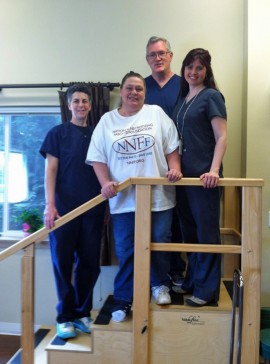 When 42-year-old Heather entered Park Manor Rehabilitation Center in Walla Walla, WA, she had already experienced more struggles than many people twice her age. With a medical history of diabetes mellitus and lower-back pain, Heather had visited the emergency room due to pain in her right lower extremity — at the time, thought to be sciatic pain. An MRI was negative for a herniated disc; however, an X-ray confirmed she had necrotizing fasciitis.
When 42-year-old Heather entered Park Manor Rehabilitation Center in Walla Walla, WA, she had already experienced more struggles than many people twice her age. With a medical history of diabetes mellitus and lower-back pain, Heather had visited the emergency room due to pain in her right lower extremity — at the time, thought to be sciatic pain. An MRI was negative for a herniated disc; however, an X-ray confirmed she had necrotizing fasciitis.
Heather’s diagnosis led to her transfer to Kadlec Medical Center, where the wound was debrided and a wound vac put in place. After receiving antibiotic treatment, she was life-lighted to Harborview Medical Center in Seattle for further care, which included debridement of the right thigh, calf and gluteal area, perineum and groin through four separate incisions. Admitted to the ICU, intubated and placed in a coma for four weeks, Heather underwent a total of 12 debridement surgeries.
During this time, Heather also developed VRE. Her family was told she had less than a 15 percent chance of survival. Despite the odds, Heather persevered and stayed at Harborview for a total of seven weeks. From there, her journey began with Park Manor Rehab for post-acute care.
With some prior experience as a CNA, Heather was high-functioning at admission and had been living with her daughter in an apartment on the ground floor. She was (I) with all ADLs, including bathing. Additionally, she was (I) with all IADLs, including driving. As for her functioning levels at evaluation, she required 100 percent mod assistance for grooming from her bed as well as maximum assistance with toileting, upper body dressing, bed mobility and transfers. She was dependent for lower body dressing and bathing and unable to ambulate.
The team at Park Manor enlisted the collaborative efforts of physical and occupational therapy to get Heather on the road to wellness. A combination of electrical stimulation and short wave diathermy in physical therapy worked to increase circulation in order to promote wound healing. Meanwhile, occupational therapy worked on increasing Heather’s upper extremity strength and coordination, activity tolerance and improving her ability to participate in functional tasks.
Upon discharge 96 days later, Heather had achieved modified independence with ambulation, grooming, toileting and upper-body dressing. She required standby assistance with lower-body dressing, minimal assistance with bathing, and modified independent or standby assistance with transfers. Perhaps most astounding was the remarkable healing of her wounds. In fact, when she went to a final appointment to schedule a skin graft for her right lower extremity prior to discharge, her doctor decided instead to suture the last remaining opening, and no skin graft was required.
Heather was discharged home to her apartment with home health services initially. Later, she returned to Park Manor for outpatient therapy. Although Heather’s necrotizing fasciitis case was complex, it served as a benchmark by which to design future treatments. Park Manor has since received two more cases of necrotizing fasciitis and also has seen an increase in patients with extensive wounds and wound vacs, which we have treated successfully with the high-volt e-stim. As for Heather, we are happy to see her continuing to make great strides in her recovery!

